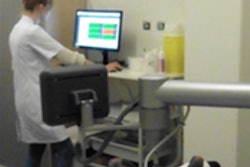
Despite intensive annual surveillance with MRI and mammography, BRCA carriers still present with interval cancers, so Dutch researchers added in automated breast ultrasound (ABUS) to see if that would help with detection. However, ABUS did not detect any additional cancers, and it's back to the drawing board.
At Radboud University Nijmegen Medical Center in the Netherlands, women with a BRCA1 or BRCA2 gene mutation are screened yearly. In addition, women with a first-degree relative with a known BRCA gene mutation are also screened annually. The protocol consists of MRI, mammography, and a physical examination, according to Jan van Zelst, a doctoral candidate at the university.
"In the screening program, we run into two challenges," he said at this month's ECR 2015 in Vienna. "One is that according to our literature, 11% to 25% of all cancers that occur are not detected by screening modalities, and this is unwarranted because of the high tumor doubling rates with BRCA 1 and BRCA 2 cancers. And these cancers are commonly more aggressive tumor subtypes and appear in younger women."

The other challenge is the value of mammography is limited, as these women have morphological features that differ from "normal" breast cancer and have dense breasts, thus making it more difficult to image on mammography. The researchers investigated whether adding ABUS twice yearly to the screening regimen would help these women in particular. ABUS was chosen over handheld ultrasound, because it's fast, standardized, and may be performed by nonradiologists with minimal training.
Van Zelst and colleagues included 295 BRCA 1/2 carriers in their study enrolled between September 2010 and November 2012. After that, the women underwent five rounds of screening in two years. All examinations were read by one of four breast radiologists.
Only 196 women completed all the rounds, and 39 women chose preventive mastectomy. In 16 women, a total of 19 cancers were detected. One additional ductal carcinoma in situ (DCIS) was found in a preventive simple mastectomy specimen and two interval cancers occurred.
| Results | |||||
| Modality | Sensitivity | Specificity | Positive predictive value | Recall rate | Cancer detection rate |
| Mammography | 0.50 | 0.97 | 0.32 | 3.7% | 11/1,000 |
| MRI | 0.88 | 0.95 | 0.28 | 7.4% | 20/1,000 |
| ABUS | 0.44 | 0.95 | 0.09 | 6.7% | 6/1,000 |
Two cancers were detected by mammography only -- both of which were DCIS in women older than age 50. ABUS did not detect otherwise unobserved cancers.
"With MRI, we detected almost all the invasive cancers and a large part of the DCIS," he said. "ABUS detected a large part of the invasive cancers, but detected none of the DCIS. ... Mammography also detects quite a large number of the invasive cancers, but we also found DCIS with microcalcifications on the mammogram that weren't seen on the MRI or the ABUS exam."
The results led van Zelst and colleagues to conclude that ABUS has no place in the current regimen for BRCA carriers, as it neither found any additional cancers nor did it detect any earlier. Plus, the positive predictive value is low.
"An additional finding in this study is that we didn't find any MRI negative cancers under the age of 50 years in this study," van Zelst said. "So this provides more evidence to postpone the onset of mammography screening in BRCA carriers to the age of 40 years. ... Although ultrasound has no role at this moment, other ultrasound techniques might be implemented to improve specificity, and this might make ABUS useful in the future."



















